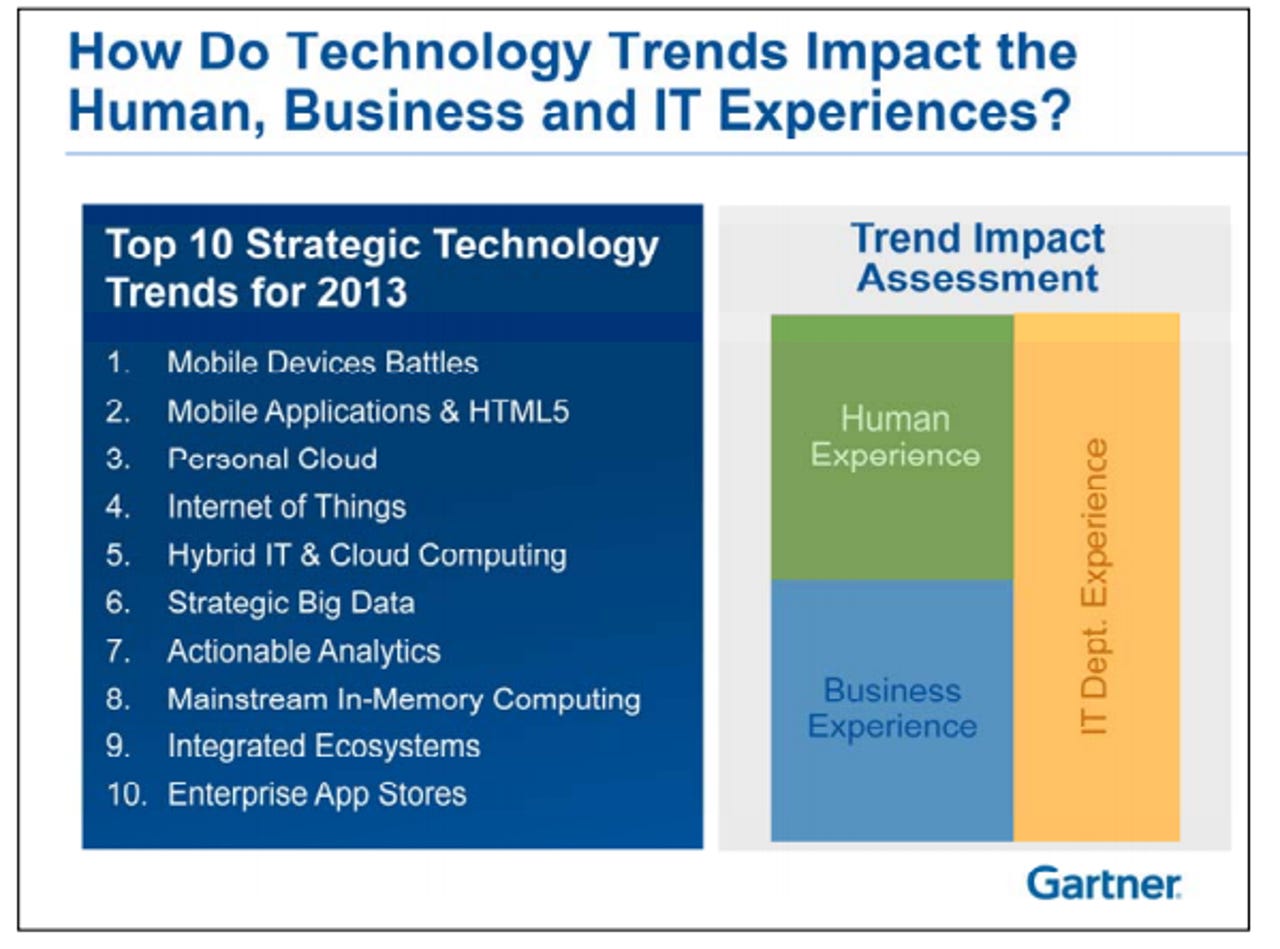Mobile, actionable data dominates Gartner's 2013 tech trends

ORLANDO---Mobile devices, applications, cloud and big data companies can actually use for strategic advantage are the headliners for Gartner's top technology trends for 2013.
Gartner analyst David Cearley outlined the technology trends to a packed room. At the Symposium, the technology trend outlook almost serves as a keynote. CIOs and tech executives duke it out for seats to listen to the technology prognostications.
Windows 8 will bring 140 form factors to market.
The theme for 2013---according to Gartner---is that the information technology department has to navigate cloud, social, mobility and information as those trends play off of each other. Cearley's take is that a strategic technology will impact the enterprise over the next three years.
"These technologies will cause major disruption to your environment," said Cearley. "This list is a starting point."
Here's the overview:

Among the key points:
Mobile as the top two picks isn't all that surprising. Most technology execs here have bring your own device on the brain. Mobile device management is top of mind too. Meanwhile, employees are bringing all sorts of devices to work. That trend could get worse since Windows 8 will bring 140 form factors to market.
Social networking isn't on the list because it is embedded in all of the themes highlighted, said Cearley.
See also: Facebook could become an enterprise ID system | RIM preps enterprise roadshow, chafes at iPad Gartner prediction | 10 corporate IT headaches over the next five years | Gartner: 'Every budget is an IT budget'
Gartner predicts that Android and iOS will dominate smartphones, but Windows Phone will gain "substantial share." For tech execs, the actual players don't manage. They have to get a handle on securing data and managing choice.
Cearley outlined a few assumptions by year end 2014:
- Android shipments will top iOS on tablets.
- Windows 8 will be an option for enterprises more than individuals.
- Enterprise app developers will see Windows tablets as a target device in 2013.
- HTML5 will be the mainstream enterprise app vehicle.
- Companies will have to exploit three different architectures for mobile apps.
- Private app stores from enterprises will balloon. RIM is betting on such a move.
Personal clouds will also play into the mobility theme for enterprises. Why? Bring your own device will yield to bring your own service as employees bring services like Dropbox to work. "The personal cloud will replace the personal computer," said Cearley.
In other areas, the Internet of things will digitize all businesses. The challenge will be making sense of all the data from image recognition, embedded sensors and other information related by physical objects. Cearley said that by 2015, 70 percent of companies will have one executive in charge of overseeing Internet-connected devices and objects. The payoff will be in the supply chain, control and information services. "The Internet of things has applications across multiple industries," said Cearley.
Cloud computing is a no brainer and Gartner has pitched for years that brokers would emerge to manage services. So far, these predictions haven't panned out completely.
On the big data and analytics front, Cearley noted that there's a difference between "strategic big data" and a flow of information. Among the key items:
- Sensor data will become dominant.
- Hadoop and NoSQL gain momentum.
- Pilots will move to production.
- The social and mobile graphs will be critical.
- Data warehouses will be revamped into new models.
- Analytics will be real time courtesy of a man-machine partnership.
These analytics tool will be enabled by mainstream in-memory computing. "In-memory will be in your world across multiple applications," said Cearley. "This will open new opportunities."
Cearley also said that integrated ecosystems will be difficult to manage. CIOs will have to balance best of breed approaches with appliances, which are simpler, but also come with more lock-in.